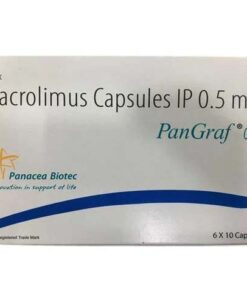Buy Pangraf : Tacrolimus 1.0 mg Capsules 60’S Online
$156.48
Brand Name: Pangraf
Active Ingredient: Tacrolimus
Manufactured by: Panacea Biotec Ltd.
Strength: 1.0 mg
Dosage Form: Capsules
Package Size: Pack of 60 Capsules
Prescription Requirement: Yes
Pangraf (Tacrolimus) is a brand-name medication that is prescribed to prevent rejection in liver, kidney, and heart transplant recipients. The medication is available in the form of capsules and contains 1.0 mg of Tacrolimus as the active ingredient. The medication is manufactured by Panacea Biotec Ltd.
Composition:
The active ingredient of Pangraf is Tacrolimus. Each capsule of Pangraf contains 1.0 mg of Tacrolimus.
Uses:
Pangraf is primarily used to prevent organ rejection in patients who have undergone liver, kidney, or heart transplants. It works by suppressing the immune system to prevent it from attacking the new organ. Pangraf is recommended for use along with other immunosuppressive agents to reduce the risk of organ rejection and improve the chances of survival.
Usage and Dosage:
Pangraf is available in the form of capsules and is taken orally, usually on an empty stomach, 12 hours apart. The dosage and duration of treatment are determined by the transplant physician based on the patient’s medical condition, age, and response to treatment. It is important to take the medication at the same time each day and not to miss any dose. The missed dose should be taken as soon as possible, but if the next scheduled dose is near, the missed dose should be skipped.
Storage Conditions:
Pangraf should be stored at room temperature (15-25°C) away from moisture, light, and heat. The medication should be kept out of reach of children and pets.
Mechanism of Action:
Tacrolimus works by suppressing the immune system’s response to foreign invaders. The medication blocks the production of cytokines and other immune cells that are responsible for rejecting the new organ. By inhibiting T-cell activation and cytokine production, Tacrolimus helps in reducing the risk of organ rejection.
Contraindications:
Pangraf is contraindicated in patients with known hypersensitivity to Tacrolimus or any of the ingredients present in the medication. The medication should not be used in patients with a history of cancer or patients with uncontrolled hypertension. It should also not be used in pregnant or lactating women.
Interactions:
Tacrolimus may interact with other medications, including antibiotics, antifungal medications, antiviral medications, immunosuppressants, grapefruit juice, and herbal supplements. Patients should inform their doctor about all the medications they are taking before starting Pangraf. The drug may also interact with some laboratory tests and give false results.
Adverse Reactions:
Some of the common side effects of Pangraf include headache, diarrhea, nausea, vomiting, abdominal pain, tremors, insomnia, and elevated blood glucose levels. Serious side effects may include fever, infections, liver or kidney damage, and neurological changes. Patients should contact their doctor immediately if they experience any serious side effects or if their condition worsens.
Be the first to review “Buy Pangraf : Tacrolimus 1.0 mg Capsules 60’S Online” Cancel reply
Related products
Immunosuppressive Drugs
Immunosuppressive Drugs
Buy Sandimmun Neoral : Cyclosporine 100 mg Capsules 50’S Online
Immunosuppressive Drugs
Buy Pangraf : Tacrolimus 0.5 mg Capsules 60’S Online For Sale
Immunosuppressive Drugs
Immunosuppressive Drugs
Buy Sandimmun Neoral : Cyclosporine 50 mg Capsules 50’S Online









Reviews
There are no reviews yet.